View in other NatureServe Network Field Guides
NatureServe
Montana
Utah
Wyoming
Idaho
Wisconsin
British Columbia
South Carolina
Yukon
California
New York
Gray Aster - Eurybia glauca
Other Names:
Aster glaucodes, Herrickia glauca
Native Species
Global Rank:
GNRT4T5
State Rank:
S3S4
(see State Rank Reason below)
C-value:
Agency Status
USFWS:
USFS:
BLM:
External Links
State Rank Reason (see State Rank above)
See rank details.
- Details on Status Ranking and Review
Population Size
Score1 - Moderate: Generally 10,000-100,000 individuals.
CommentPopulation size is unknown for Montana, but due to its limited distribution is estimated to be <100,000 plants.
Range Extent
Score3 - Local Endemic or Very Small Montana Range: Generally restricted to an area <10,000 sq. miles (equivalent to the combined area of Phillips and Valley Counties) or <6 Sub-basins (4th code watersheds) Range-wide OR limited to one Sub-basin in Montana
CommentIn Montana, the species is known from Carbon County, though may also occur in Big Horn County.
Area of Occupancy
Score1 - Moderate: Generally occurring in 11-25 Subwatersheds (6th Code HUC’s).
Environmental Specificity
Score1 - Moderate: Species is restricted to a specific habitat that is more widely distributed or to several restricted habitats and is typically dependent upon relatively unaltered, good-quality habitat (C Values of 5-7).
Trends
ScoreNA - Rank factor not assessed.
CommentTrends are unknown, though habitat is generally stable and populations have probably not declined significantly.
Threats
Score0-1 - Low to Medium.
CommentThreats to the species' viability appear to be insignificant to low.
Intrinsic Vulnerability
Score0 - Low Vulnerability: Species does not have any unusual or specific life history or biological attributes or limted reproductive potential which makes it susceptible to extirpation from stochastic events or other adverse impacts to its habitat and thus slow to recover.
CommentNo specific factors are known which are believed to increase the species' vulnerability.
Raw Conservation Status Score
Score
6 to 7 total points scored out of a possible 16 (Rarity factors and threats only).
General Description
Gray Aster is a perennial with simple or branched, mostly hairless stems that are 20-70 cm tall, and arise from rhizomes with many stems forming colonies. There are numerous alternate, stalkless, entire margined leaves that are 4-12 cm long by 0.5-2.5 cm wide and are hairless and glaucous. The lowermost leaves are smaller and scale-like. The flowers are borne in several to many composite heads of ray and disk flowers surrounded by an involucre of bracts borne on spreading branches. The involucre is 6-9 mm high and is composed of several series of overlapping bracts; the outer bracts are broad and firm, and the inner bracts are narrower and longer and often have purplish tinged midribs. The 8-19 strap-shaped rays are pale lavender and 8-18 mm long by 1-2 mm wide. The disk is 7-12 mm in diameter and consists of numerous flowers with tubular corollas that are shorter than the rays. The bases of both ray and disk corollas are encircled by a pappus of slender white bristles. Achenes are hairless or sparsely short-hairy near their tip.
Phenology
Flowering in August.
Diagnostic Characteristics
It is distinguished from other similar species previously classified in Aster in Montana by the combination of the rhizomatous perennial habit, glabrous stems and glaucous leaves, and an involucre of broad stiff bracts that are green only on the midrib and tip.
Species Range
Montana Range
Range Descriptions
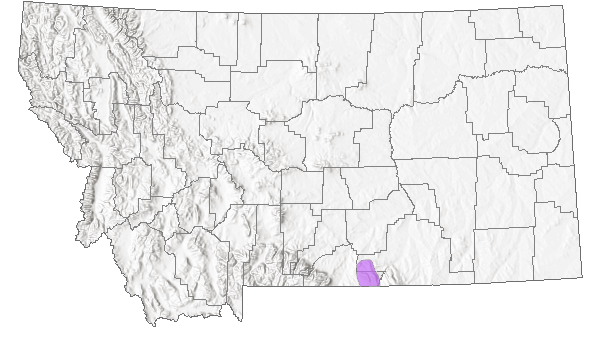
 Native
Native
Range Comments
In Carbon County MT, south to AZ and NM (Lesica et al. 2012. Manual of Montana Vascular Plants. BRIT Press. Fort Worth, TX).
Observations in Montana Natural Heritage Program Database
Number of Observations: 20
(Click on the following maps and charts to see full sized version)
Map Help and Descriptions
Relative Density
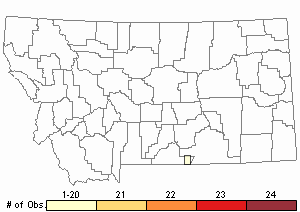
Recency
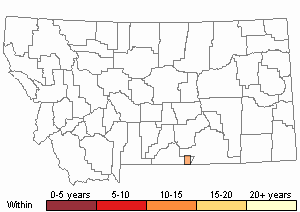

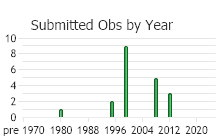
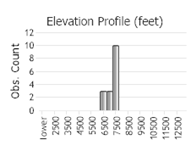 (Observations spanning multiple months or years are excluded from time charts)
(Observations spanning multiple months or years are excluded from time charts)
Habitat
Limestone outcrops and shallow soils with limestone parent material.
Ecology
POLLINATORS The following animal species have been reported as pollinators of this plant species or its genus where their geographic ranges overlap:
Bombus vagans,
Bombus ternarius, and
Bombus terricola (Colla and Dumesh 2010).
Stewardship Responsibility
References
- Literature Cited AboveLegend:
 View Online Publication
View Online Publication Colla, S.R. and S. Dumesh. 2010. The bumble bees of southern Ontario: notes on natural history and distribution. Journal of the Entomological Society of Ontario 141:39-68.
Colla, S.R. and S. Dumesh. 2010. The bumble bees of southern Ontario: notes on natural history and distribution. Journal of the Entomological Society of Ontario 141:39-68. Lesica, P., M.T. Lavin, and P.F. Stickney. 2012. Manual of Montana Vascular Plants. Fort Worth, TX: BRIT Press. viii + 771 p.
Lesica, P., M.T. Lavin, and P.F. Stickney. 2012. Manual of Montana Vascular Plants. Fort Worth, TX: BRIT Press. viii + 771 p.
- Additional ReferencesLegend:
 View Online Publication
View Online Publication
Do you know of a citation we're missing? Lesica, P., M.T. Lavin, and P.F. Stickney. 2022. Manual of Montana Vascular Plants, Second Edition. Fort Worth, TX: BRIT Press. viii + 779 p.
Lesica, P., M.T. Lavin, and P.F. Stickney. 2022. Manual of Montana Vascular Plants, Second Edition. Fort Worth, TX: BRIT Press. viii + 779 p. Lesica, P., P. Husby, and S. V. Cooper. 1998. Noteworthy collections: Montana. Madrono 45:328-330.
Lesica, P., P. Husby, and S. V. Cooper. 1998. Noteworthy collections: Montana. Madrono 45:328-330.
- Web Search Engines for Articles on "Gray Aster"





